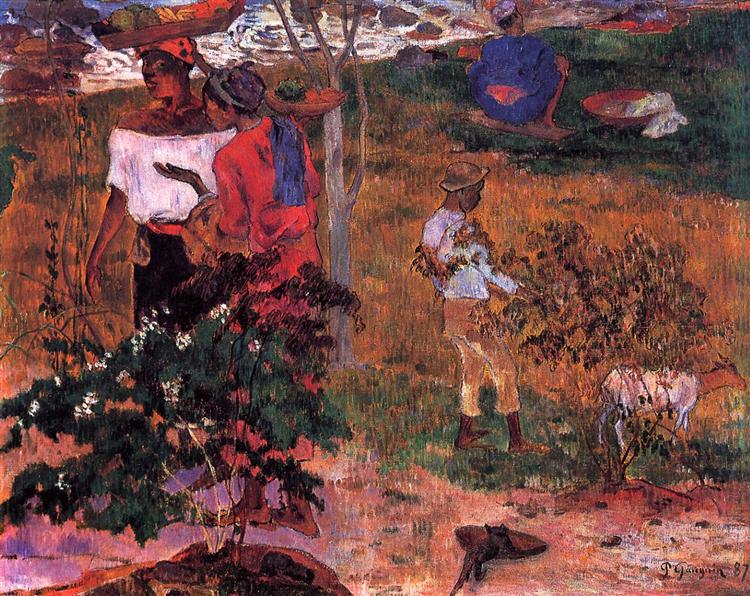Description
Paul Gauguin's Tropical Conversation, painted in 1887, is a clear example of the artist's quest to capture the essence of life and culture in exotic settings, a recurring theme in his work. In this painting, Gauguin transports us to the vibrant world of Tahiti, where he moved in 1891, and where he found inspiration in its landscapes and the daily lives of its inhabitants. Although Tropical Conversation was not painted during his Tahitian period, it already displays Gauguin's fascination with the simplicity and beauty of the natural and human environment that would define his later work.
The composition of the painting plays a fundamental role in the message that the artist is trying to communicate. At the centre of the work are seated figures of women, depicted with solid shapes and vibrant colours, who seem to be engaged in a conversation, a symbol of the connection between them and their surroundings. The atmosphere of the painting is imbued with a sense of intimacy and warmth, accentuated by the use of complementary colours that reinforce the liveliness of the tropical scene. Touches of pink, green and blue create a palette that, although stylised, resonates with the reality of its surroundings, revealing the influence of Impressionism that Gauguin was leaving behind in favour of a more symbolic and emotive expression.
The characters in “Tropical Conversation” are dressed in clothing evoking indigenous culture, echoing the artist’s quest to present the figures not only as subjects of aesthetic interest, but as entities with their own history and meaning. Their faces, outlined with a dark stroke, suggest emotions that invite the viewer to reflect on the social interaction depicted in the work. The expressions are contemplative, as if they were participating in a dialogue that transcends mere conversation, becoming a cultural exchange.
Gauguin, being a precursor of symbolism, seeks in this work to represent not only visual reality, but also the interiority of his characters and their relationship with the nature that surrounds them. The lush vegetation that surrounds the figures is not just a backdrop but resides in a search for harmony with the environment. The way in which the leaves and flowers intertwine with the figures suggests an intrinsic connection between humans and their habitat, an idea that appears constantly in Gauguin's work.
Through Tropical Conversation, Gauguin challenges the traditional conception of painting at the time. This painting is a testament to his evolution towards an art form that advocates emotional expression and symbolism. His fascination with the Polynesian world is translated into the work not only through its content, but also in its distinctive style, with its focus on the simplification of forms and an enriched palette that becomes a narrative element. When looking at the painting, one feels invited to participate in a world where the rhythm of life and nature merge into a single visual narrative, urging the viewer to explore not only the surface of the painting, but the depths of the meanings it can offer.
"Tropical Conversation" confronts us with the complexity of human relationships and their environment, making it a work worthy of being studied and appreciated not only for its technique and color, but also for the cultural dialogue it establishes. In this sense, Gauguin establishes himself as a great innovator of his time, who anticipated modernism by blurring the boundaries between reality, art and human experience.
KUADROS ©, a famous painting on your wall.
Hand-made oil painting reproductions, with the quality of professional artists and the distinctive seal of KUADROS ©.
Painting reproduction service with satisfaction guarantee. If you are not completely satisfied with the replica of your painting, we will refund 100% of your money.

